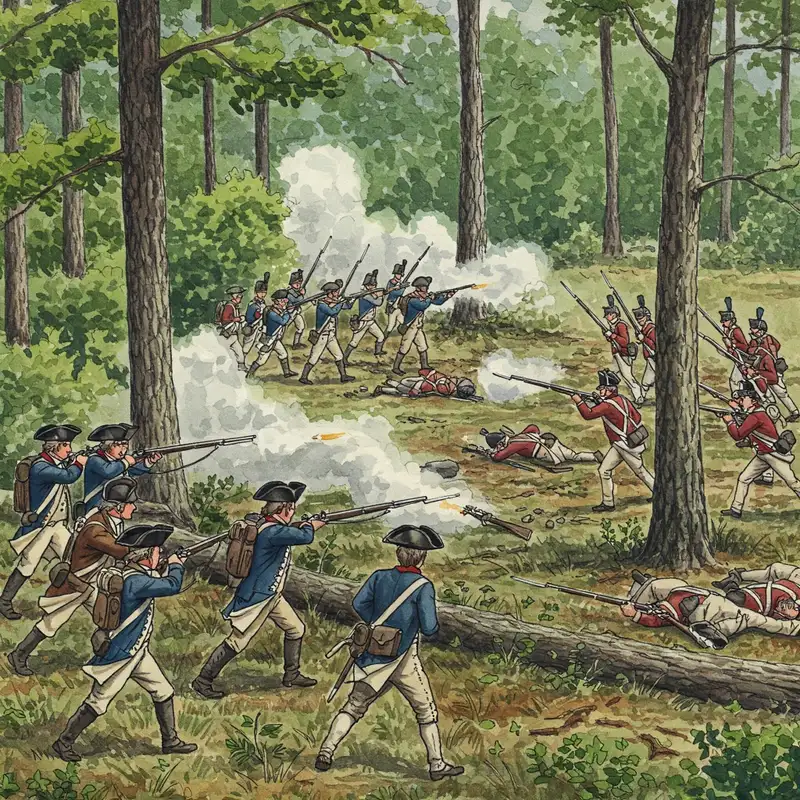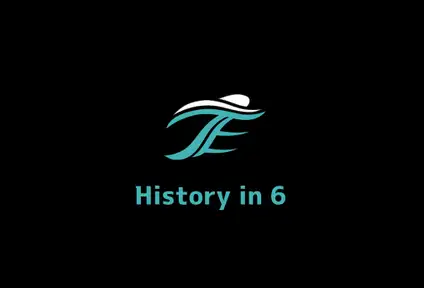Battle of Fort Ann
Burgoyne's army arrived at Fort Ticonderoga in early July. British troops landed on the western shore while German forces moved down the eastern shore, threatening the American escape route. British engineers quickly realized the strategic value of Mount Defiance. The Americans had withdrawn from their outer position at Mount Hope, leaving it accessible. Working quickly and unnoticed, the British cleared the summit and hauled heavy cannons up the steep slope. By July 5th, the Americans awoke to a terrifying sight: British artillery on the heights, making their position impossible to defend.
St. Clair had a terrible choice to make. Defending the fort against the artillery was impossible and would mean losing the entire army. Retreating meant abandoning America's most famous fortress without a fight, risking public outrage and ruining his reputation. As he put it, he could either "save his character and lose the army" or "save the army and lose his character." St. Clair held a council of war. General Schuyler had ordered him to preserve the army if possible, so St. Clair made the difficult but smart decision to evacuate.
The Americans withdrew under cover of darkness on the night of July 5th. They split up and took two different routes. St. Clair led the main force across a bridge of boats to Mount Independence. From there, they retreated overland southeast on the rough Hubbardton road towards Castleton, Vermont.
Colonel Pierse Long led a smaller group of about 600 men south by water. His flotilla included the sick, wounded, camp followers, and essential supplies. The armada consisted of five armed galleys and a number of bateaux which are flat-bottomed, sharp-ended, shallow-draft boats. They were headed for Skenesboro at the southern tip of Lake Champlain. The evacuation itself was chaotic. Loading the boats in the dark was slow and difficult. They had to spike and abandon valuable equipment, including heavy cannons. But they were able to successfully escape the British army.
Burgoyne discovered the evacuation on July 6th and immediately gave chase. He split his forces, sending Brigadier General Simon Fraser and the Advanced Corps after St. Clair. Major General Riedesel followed with German reinforcements. The pursuit led to the Battle of Hubbardton on July 7th. The British won that battle, but it cost them dearly in terms of casualties and valuable time. Allowing St. Clair's main force to escape.
At the same time, Burgoyne sent some of his forces after Colonel Pierse Long's waterborne group, who were heading south to Skenesboro. British gunboats quickly caught up with the Americans near Skenesboro around July 6th. The Americans struggled to move their boats and supplies around a blockage to Wood Creek, and that's when the British opened fire. It was chaos. The Americans sank or burned three of their armed ships to keep them from being captured, while two others were forced to surrender. They lost a lot of much-needed supplies and baggage that had been loaded at Ticonderoga. The disorganized remnants of Long's command fled overland towards Fort Anne, setting fire to Skenesboro and leaving it largely destroyed.
Burgoyne then sent Lieutenant Colonel John Hill and a small force of nearly 200 regulars from Skenesboro to chase after Long's retreating men. Hill's group followed the Americans along the rough, twelve-mile wilderness road that ran alongside Wood Creek towards Fort Anne. The terrain slowed the British down and gave the Americans cover. On July 7th, Hill captured several boatloads of American wounded and supplies on Wood Creek before setting up camp about a mile north of Fort Anne.
Meanwhile, Colonel Pierse Long and his exhausted troops reached Fort Anne in the early hours of July 7th. Their numbers were reduced after the Skenesboro fight. Luckily for them, reinforcements sent by Major General Philip Schuyler arrived at the same time. Colonel Henry K. Van Rensselaer showed up with about 400 New York militia. This significantly boosted the number of American men at Fort Anne, now somewhere between 700 and 1,000. They now greatly outnumbered Hill's pursuing force.
----
The Americans, aware of the approaching British and emboldened by their increased numbers, didn't just wait around. On the evening of July 7th, Captain James Gray led a group of 150 Continentals and some rangers to engage Hill's advance elements. This preemptive strike pushed the British out of their initial encampment and forced them into a defensive position on Battle Hill. This prevented an immediate attack on Fort Anne and set the stage for the main battle the next day. Burgoyne's decision to pursue both retreating American columns was aggressive, but it stretched his advance guard thin. This, combined with the timely arrival of American reinforcements along with the difficult terrain, gave the Americans at Fort Anne a chance to turn the tables on their pursuers. They now had a significant numerical advantage.
By dawn on July 8th, everything was set for a showdown near the dilapidated Fort Anne. The two forces were a stark contrast in numbers, and neither was necessarily combat-ready after days of retreat and pursuit.
But the day began with a bit of espionage. An American soldier, pretending to be a deserter, entered Lieutenant Colonel Hill's camp early that morning. He told the British commander that Fort Anne was held by nearly 1,000 demoralized troops who were afraid of an attack. This information - likely exaggerated but perhaps accurate about the Americans' fatigue - convinced Hill, who only had about 190 men, that he was too outnumbered to attack the fort directly. He sent a message back to Burgoyne at Skenesboro asking for urgent reinforcements. Shortly after, the "deserter" vanished, and this is when the British realized he was actually a spy sent to check their strength. This confirmation of the small British detachment likely solidified the American commanders' decision to go on the offensive. They saw a clear chance to strike before help could arrive.
The American attack began mid-morning and quickly escalated into a brutal fight that raged for hours. Long and Van Rensselaer led the charge, guiding their Continentals and militia out of Fort Anne toward Hill's position on Battle Hill, about a mile north. Using the dense woods to their advantage, the Americans adopted clever light infantry tactics. They moved stealthily from tree to tree, taking cover and firing with precision. Their main strategy was to surround the British; some troops moved up Wood Creek on the British left, others maneuvered through the woods to attack the British front, flank, and rear all at once.
Although outnumbered, the British regulars of the 9th Foot initially held their ground. The coordinated flanking attacks soon put immense pressure on them, though. Hill, seeking to avoid encirclement, had no choice but to order a withdrawal to the crest of a nearby steep, wooded hill – Battle Hill. The retreat was chaotic and devolved into a running firefight as the British scrambled up the slope. During this phase, Captain William Montgomery of the 9th was mortally wounded and had to be left behind with the regimental surgeon. The advancing Americans later found both men in the abandoned British camp. Once the British reached the top of the hill, they employed unconventional tactics to match the terrain and the desperation of their situation. To maximize their front and avoid being completely surrounded on the narrow ridge, they formed a single-file line, abandoning the standard two-rank formation.
The battle slowly ground to a stalemate. The British held the high ground, which let them fire down on the Americans. However, the dense woods and steep slope made it hard to see their targets and prevented effective counterattacks. The Americans used the terrain for cover and pressed their attack fiercely, but they couldn't dislodge the British from their hilltop position. Both sides were running dangerously low on ammunition after hours of continuous fighting. Just as the Americans were gathering for what might have been a final push, the sound of Native American war whoops suddenly filled the forest. This was the battle’s turning point.
The American troops, already exhausted and low on ammunition, were terrified of Native American warfare. They feared being trapped between Hill's force and a fresh wave of attackers. The uncertainty, combined with their depleted state, led Long and Van Rensselaer to call off the attack. The Americans made an orderly retreat back toward Fort Anne, carrying their wounded with them
The funny thing is the whoops didn't come from a large force of warriors, but from Captain John Money, Burgoyne's Deputy Quartermaster-General. He had arrived with only a small group of hesitant Native American allies. Unable to convince the warriors to join the fight, Money took matters into his own hands and let out the whoops himself to create the illusion that a major reinforcement was imminent.
The trick worked perfectly.
Back at the fort, American commanders huddled up. They'd gotten word – maybe it was true, maybe it wasn't – that a huge British force led by Brigadier General William Phillips was closing in fast from Skenesboro. Supplies were low, ammo was almost gone, and another attack by a stronger enemy was likely. So, they made the call to abandon Fort Anne. Before heading south to Fort Edward and General Schuyler's main army, the Americans torched the stockade and everything around it, making sure the British couldn't use it. As they left, they chopped down trees and blocked the already rough road, a move that would seriously slow down Burgoyne's army in the weeks to come.
The actual number of casualties from the battle is unclear, as historical accounts don't agree, especially about the number of captured soldiers. But even with these differences, it's clear that both sides suffered significant losses, especially considering how small the forces were. The Americans are thought to have lost about 7 men, with 13 wounded and 30 captured. However, these numbers could be as high as double that. The British lost 13 men, with 23 wounded and somewhere between 15 and 55 captured.
As many as half of the British regiment were casualties. If the higher capture numbers are accurate, Hill's forces were nearly wiped out and only saved by a timely ruse and American withdrawal.
While the British technically won the Battle of Fort Anne, the real victory for the Americans was the strategic impact on the Saratoga campaign. The intense fighting on July 8th, and the Americans' efforts to block the road south, significantly delayed the British.
This delay was crucial. The battle itself took a whole day, and Hill had to wait for reinforcements before moving on. Even worse for the British, Long's men chopped down massive trees and destroyed bridges as they retreated, turning the road into an impassable mess. Burgoyne's army wasted precious time and resources hacking through the wilderness - weeks of them! This ate up their supplies and slowed their momentum. Burgoyne needed speed to reach Albany before running out of supplies and facing stronger American resistance. The delays at Fort Anne threw a serious wrench into his plans.
The time gained was incredibly important for the Americans. General Schuyler was able to regroup his forces after the shock of losing Fort Ticonderoga. He was able to move supplies out of vulnerable areas and began using new tactics to slow Burgoyne down. They destroyed bridges, blocked rivers, and took all the food they could find so the British would have nothing left to forage. The stand at Fort Anne along with the tough fight at Hubbardton, showed them they could take on the British and Germans. This resilience helped them shake off the loss at Ticonderoga and got more people to join the war effort. The battle showed that both the regular soldiers and the militia could fight well when they had good leadership and the right terrain.

